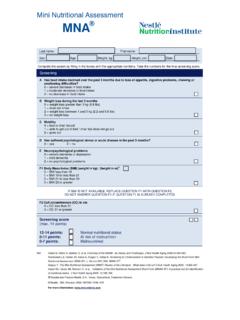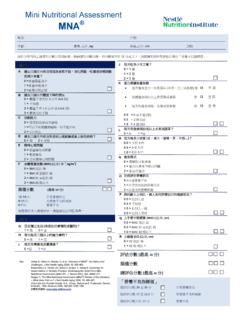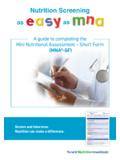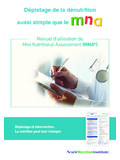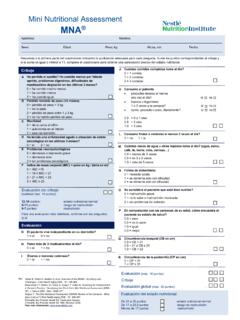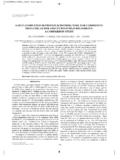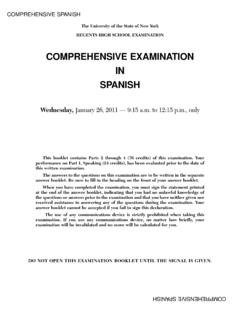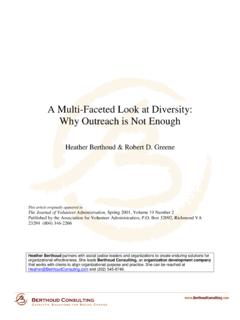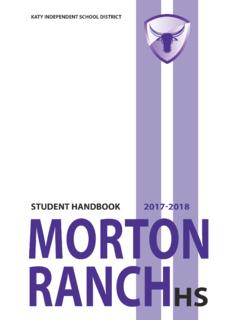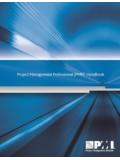Transcription of THE MINI NUTRITIONAL ASSESSMENT (MNA®) …
1 The Journal of Nutrition, Health & Aging Volume 10, Number 6, 2006466 IntroductionMultidimensional geriatric ASSESSMENT targeting the elderlywho need care is effective when used with follow up visits (1,2). Geriatric ASSESSMENT uses well-validated instruments thatencompass the major ASSESSMENT domains: Activities of DailyLiving (3), Instrumental Activities of Daily Living (4), mini -Mental State Examination (5), Geriatric Depression Scale (6),and Tinetti balance/gait evaluation (7). Too little attention,however, has been given to identifying those elderly whowould benefit from early detection of malnutrition. Theprevalence of malnutrition is relatively low in free-livingelderly (2 10%), but rises considerably (30 60%) in thehospitalized or institutionalized elderly (8).
2 Nutritionalassessment becomes crucial because progressive undernutritionoften goes undiagnosed (9). Therefore, as a first-line strategy,we developed the mini NUTRITIONAL ASSESSMENT (Figure 1) toidentify the elderly at risk of malnutrition and guide optimalnutritional intervention (8, 10, 11). The MNA instrument wasvalidated in a series of studies to assess which geriatric patientsare at risk for malnutrition (11). It can be easily administeredby health professionals in geriatric clinics or on admission tohospitals and nursing homes to detect patients who could behelped by early nutrition intervention. The MNA should beintegrated in the comprehensive geriatric ASSESSMENT (12, 13).Literature searchTo review the literature through Spring 2006, we searchedMEDLINE (PubMed), Web of Science, & Scopus using thekeywords NUTRITIONAL Status, Screening, Sensitivity andSpecificity, Frail Elderly, Aged, Aged 80 and over, and MiniNutritional ASSESSMENT .
3 In addition, we searched MEDLINE(PubMed) & Scopus further for related articles and completed aTHE mini - NUTRITIONAL ASSESSMENT (MNA ) REVIEW OF THE LITERATURE WHAT DOES IT TELL US?THE mini NUTRITIONAL ASSESSMENT (MNA )REVIEW OF THE LITERATURE WHAT DOES IT TELL US?Y. GUIGOZN estl Product & Technology Centre, Nestl -Strasse 3, CH-3510 Konolfingen, Switzerland. Address: Applied Science & Quality Assurance, Nestl Product Technology Centre,Nestl Strasse 3, 3510 Konolfingen, Switzerland, Tel.: +41 31 790 1509, Fax: +41 31 790 1552, E-mail: review the literature on the MNA to Spring 2006, we searched MEDLINE, Web of Science &Scopus, and did a manual search in J Nutr Health Aging, Clin Nutr, Eur J Clin Nutr and free online availablepublications. Validation and validity:The MNA was validated against two principal criteria, clinical status andcomprehensive nutrition ASSESSMENT using principal component and discriminant analysis.
4 The MNA short-form (MNA -SF) was developed and validated to allow a 2-step screening process. The MNA and MNA -SFare sensitive, specific, and accurate in identifying nutrition risk. NUTRITIONAL Screening:The prevalence ofmalnutrition in community-dwelling elderly (21 studies, n = 14149 elderly) is 2 (mean SE, range 0-8%) and risk of malnutrition is 24 (range 8-76%). A similar pattern is seen in out-patient and home careelderly (25 studies, n = 3119 elderly) with prevalence of undernutrition 9 (mean SE, range 0-30%) andrisk of malnutrition 45 (range 8-65%). A high prevalence of undernutrition has been reported inhospitalized and institutionalized elderly patients: prevalence of malnutrition is 23 (mean SE, range 1-74%) in hospitals (35 studies, n = 8596) and 21 (mean SE, range 5-71%) in institutions (32 studies, n =6821 elderly).
5 An even higher prevalence of risk of malnutrition was observed in the same populations, with 46 (range 8-63%) and 51 (range 27-70%), respectively. In cognitively impaired elderly subjects(10 studies, n = 2051 elderly subjects), detection using the MNA , prevalence of malnutrition was 15 (mean SE, range 0 62%), and 44 (range 19 87%) of risk of malnutrition. Characteristics:The largevariability is due to differences in level of dependence and health status among the elderly. In hospital settings, alow MNA score is associated with an increase in mortality, prolonged length of stay and greater likelihood ofdischarge to nursing homes. Malnutrition is associated with functional and cognitive impairment and difficultieseating. The MNA detects risk of malnutrition before severe change in weight or serum proteins Intervention:Intervention studies demonstrate that timely intervention can stop weight loss in elderlyat risk of malnutrition or undernourished and is associated with improvements in MNA scores.
6 The MNA can also be used as a follow up ASSESSMENT tool. Conclusion:The MNA is a screening and ASSESSMENT tool witha reliable scale and clearly defined thresholds, usable by health care professionals. It should be included in thegeriatric ASSESSMENT and is proposed in the minimum data set for NUTRITIONAL words:Elderly, NUTRITIONAL screening, NUTRITIONAL ASSESSMENT , mini NUTRITIONAL used in this paper:MNA , mini NUTRITIONAL ASSESSMENT ; MNA -SF, MNA screening form;BMI, Body Mass search of J Nutr Health Aging, Clin Nutr, Eur J ClinNutr and free online available publications (including Spanishand French publications). A partial literature review waspublished in 2002 (10). Finally abstracts from ESPEN andIANA were screened for the word MNA. We found 122studies that reported the percentage of elderly at risk andmalnourished (see tables); only 2 studies found weaknesses inthe discrimination potential of the full MNA (14, 15) and 2studies of the MNA -SF (16, 17).
7 Next, 62 reviews of care forthe elderly (nutrition or global ASSESSMENT ) including 7 reviewsabout the MNA (in 4 languages) were found (see Table 8)with only 4 recommending further evaluation of the , 52 abstracts using the MNA were found at ESPENand IANA meetings (2002-2005); however, these are notincluded summary we found studies performed in over 30,000elderly subjects in different settings (community, generalpractitioner, home care, outpatient, hospital, and institution)from different countries and suggest that it is widely used fornutritional and validation of the MNA The MNA , a single and rapid nutrition ASSESSMENT , wasdeveloped to assess nutrition status as part of the standardevaluation of elderly patients in clinics, nursing homes,hospitals, or among those who are otherwise frail.
8 A jointeffort of the Centre for Internal Medicine and ClinicalGerontology of Toulouse (France), the Clinical NutritionProgram at the University of New Mexico (USA), and theNestl Research Centre in Lausanne (Switzerland), it wasvalidated in 3 studies on more than 600 elderly subjects (8, 11).It was designed to meet the following specifications: 1) reliablescale; 2) clearly defined thresholds; 3) compatibility with theskills of a generalist assessor; 4) minimal opportunity for biasintroduced by the data collector; 5) acceptability by patients;and 6) low cost (11, 17).The MNA was validated using two principal criteria: 1)Clinical Status, which consisted of a nutrition assessmentconducted independently by two physicians trained in nutritionon the basis of the subject's clinical record (including thecomprehensive NUTRITIONAL ASSESSMENT ) without knowledge ofthe MNA results; and 2) Comprehensive nutrition ASSESSMENT ,which included a complete ASSESSMENT of anthropometrics(weight, height, knee height, mid-arm and calf circumferences,triceps and subscapular skinfolds).
9 Biochemical markers(albumin, prealbumin, creatinine, transferrin, ceruloplasmin, C-reactive protein, a1pha-1-acid glycoprotein, cholesterol,triglycerides, vitamins A, D, E, B1, B2, B6, and B12, folate,copper, zinc, haemoglobin, blood cell count and differential);and dietary intake (3-day food records combined with a food-frequency questionnaire) according to the SENECA study (18).Subjects were classified using principal component anddiscriminant analysis. Principal component analysis indicatedthat the MNA can be used without clinical biochemistry; thiswas confirmed by discriminant analysis. Threshold valueranges for risk of malnutrition and malnutrition were 22-24points and 16-18 points, respectively, on a maximum of 30points. Exact threshold values were set by cross-tabulation ofcut-off values for serum albumin without the presence ofinflammation (11).
10 The full MNA includes 18 items grouped in 4 rubrics:anthropometric ASSESSMENT (BMI calculated from weight andheight, weight loss, and arm and calf circumferences; items B,F, Q and R ); general ASSESSMENT (lifestyle, medication,mobility and presence of signs of depression or dementia; itemsC, D, E, G, H and I); short dietary ASSESSMENT (number ofmeals, food and fluid intake, and autonomy of feeding; items A,J, K, L, M and N); and subjective ASSESSMENT (self perceptionof health and nutrition; items O and P). The full MNA can becompleted in less than 15 minutes. Each answer has anumerical value and contributes to the final score, which has amaximum of 30 (Figure 1). With threshold values of 24 forwell-nourished, for at risk of malnutrition, and <17 formalnourished, the sensitivity, specificity and positive predictivevalues according to the clinical status were 96%, 98% and 97%(19).

